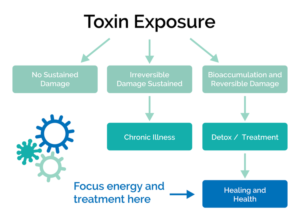Before outlining a practical approach to treating mold illness patients, James Neuenschwander, M.D. provides a step-by-step description of the cellular response to toxins. The health information we consume frequently refers to “toxins” and “toxicity” without explaining how cellular processes are altered by toxic compounds. These cellular responses to toxins can manifest as the myriad and often baffling symptoms that chronic patients report.
He begins with the cell danger response (CDR), which triggers a cascade of cellular responses that may result in the recycling of organelles or end in apoptosis of the cell itself. Apoptosis or “programmed cell death” is a normal process of growth and development, as well as a defence against pathogens. In a healthy state, cells are replaced, differentiated, and reconnected with neighbouring cells.
Disease develops when the cellular healing process gets stuck; this can occur when mold and mycotoxin exposure is ongoing. Dr Neuenschwander points out that if the host is sick, the host microbiome will also be out of balance and show signs of dysbiosis.

The full presentation includes the role of mitochondria, thought of primarily as energy producers, but which are very involved in the cellular response to stress. The presence of ATP outside the cell is part of cellular danger signalling, along with the appearance of various caspase enzymes at several points in the apoptosis process. The cell resorts to aerobic glycolysis, oxidative stress and glutamate level increase, glutathione is diverted, vitamin D production drops, and methylation reactions are impaired. Eventually, thyroid function is thrown off, and histamine increases. Patients with a chronic toxic load may develop MCAS and other indications of immune upregulation.
Dr Neuenschwander mentions the myriad patient symptoms that can result from toxic processes instigated by mycotoxin exposure: psychiatric and cognitive symptoms, any chronic syndrome, respiratory symptoms, as well as POTS and other vagal symptoms. He uses Organic Acid Test (OAT) results and MycoTOX Profile results to illustrate possible responses to mycotoxins such as trichothecenes, aflatoxins, zearalenone, and ochratoxins. He also discusses the utility of specific immune and neurological testing.

An individual patient workup is included in this presentation and emphasis is placed on the removal of mycotoxin exposure as determined by environmental testing. Food can also be a source of mycotoxins, particularly ochratoxin for which digestive binders are useful. Dr Neuenschwander points out that unsprayed, organic food can often have higher mould content. He notes that the sickest patients have mould colonization and an upregulated immune response to mycotoxin exposure and notes when antifungal treatment is called for.
CPE Points: Course completion provides you with a Certificate of Attendance so you can earn CPE Points.
Terms: This course is subject to future edits and alterations.
Notes: Notes are not available for this presentation (if no notes are available).











































